Cladistics Study guides, Class notes & Summaries
Looking for the best study guides, study notes and summaries about Cladistics? On this page you'll find 158 study documents about Cladistics.
All 158 results
Sort by
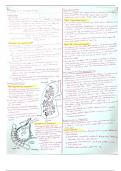 Popular
Popular
-
IB Biology SL 2 notes
- Interview • 10 pages • 2023
-
- $7.99
- 1x sold
- + learn more
IB Bio SL 2, covers: Cell Respiration; Photosynthesis; Species, Communities, and Ecosystems; Energy Flow; Carbon Cycling; Evidence for Evolution; Natural Selection; Classification of Biodiversity; Cladistics; Digestion; The Blood System; Gas Exchange; Nutrition; The Heart
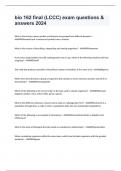
-
bio 162 final (LCCC) exam questions & answers 2024
- Exam (elaborations) • 25 pages • 2024
-
Available in package deal
-
- $10.49
- + learn more
bio 162 final (LCCC) exam questions & answers 2024 What is the primary reason protists and bacteria are grouped into different domains? - ANSWERSbacteria lack a nucleus but protists have a nucleus What is the science of describing, categorizing and naming organisms? - ANSWERStaxonomy If you were using cladistics to build a phylogenetic tree of cats, which of the following would be the best outgroup? - ANSWERSwolf The mold that produces penicillin is Penicillium notatum. Penicillium...

-
SCIN 130 Quiz 2. Questions and Answers. American Public University
- Exam (elaborations) • 23 pages • 2022
-
- $11.99
- 1x sold
- + learn more
Part 1 of 7 - Chapter 2 27.0 Points Question 1 of 31 3.0 Points What is the attraction between water molecules and other molecules, allowing water to “climb up a straw,” for example? A. cohesion B. surface tension C. solvent D. adhesion E. covalent bond Feedback:Great job. Question 2 of 31 3.0 Points What are the monomers that make up proteins? . A. steroids B. amino acids C. oils D. DNA Feedback:Great job. Question 3 of 31 3....
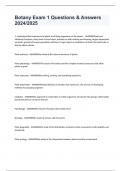
-
Botany Exam 1 Questions & Answers 2024/2025
- Exam (elaborations) • 13 pages • 2024
-
Available in package deal
-
- $8.99
- + learn more
Botany Exam 1 Questions & Answers 2024/2025 1. Understand the importance of plants to all living organisms on the planet. - ANSWERSFood and Medicinal Purposes, entry level on food chain, provides us with clothing and housing, oxygen dependent on plants, growth of human population will have a huge impact on limitations of food= this inderectly or directly effects plants. Plant anatomy - ANSWERSthe study of the internal structure of plants Plant physiology, - ANSWERSThe study of functio...
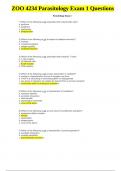
-
ZOO 4234 Parasitology Exam 1 Questions With Correct Answers | Latest Graded A+
- Exam (elaborations) • 8 pages • 2023
- Available in package deal
-
- $13.49
- + learn more
ZOO 4234 Parasitology Exam 1 Questions With Correct Answers | Latest Graded A+. Which of the following is not an aspect of adaptive immunity? a. memory b. nonself recognition c. antigen-specific d. localized response 3) Which of the following is not associated with cytotoxic T cells? a. T-cell receptor b. kill infected cells c. B-cell receptor d. CD8 receptor 4) Which of the following is not a basic assumption in cladistics? a. change in characteristics occurs in lineages over time b...
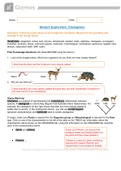
-
Cladograms Gizmo
- Exam (elaborations) • 12 pages • 2023
-
- $10.49
- + learn more
Vocabulary: adaptation, amino acid, amnion, artiodactyla, bipedal, clade, cladistics, cladogram, convergent evolution, evolution, flower, mammary glands, molecular, morphological, multicellular, parsimony, sagittal crest, phloem, selenodont teeth, SNP, xylem Prior Knowledge Questions (Do these BEFORE using the Gizmo.) 1. Look at the images below. Which two organisms do you think are most closely related? I think that the Deer and the Turtle are more closely related. Worm Deer Turtle 2. Wh...
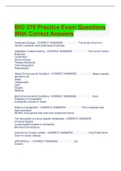
-
BIO 370 Practice Exam Questions With Correct Answers
- Exam (elaborations) • 16 pages • 2023
-
Available in package deal
-
- $11.39
- + learn more
BIO 370 Practice Exam Questions With Correct Answers Vertebrate Zoology - CORRECT ANSWERS The study of the form, function, evolution, and relationship of animals Adaptation is determined by - CORRECT ANSWERS Form and Function: Body plan Locomotion Gas Exchange Feeding Structures Thermoregulation Reproduction Abiotic Environmental Condition - CORRECT ANSWERS Space (aquatic, terrestrial, air) Water Temperature Li...
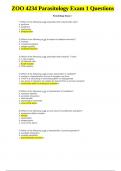
-
ZOO 4234 Parasitology Exam 1 Questions and Answers Latest Updated 2024
- Exam (elaborations) • 8 pages • 2023
- Available in package deal
-
- $15.49
- + learn more
ZOO 4234 Parasitology Exam 1 Questions and Answers Latest Updated 2024. Which of the following is not associated with natural killer cells? a. perforins b. apoptosis c. granzymes d. phagocytosis 2) Which of the following is not an aspect of adaptive immunity? a. memory b. nonself recognition c. antigen-specific d. localized response 3) Which of the following is not associated with cytotoxic T cells? a. T-cell receptor b. kill infected cells c. B-cell receptor d. CD8 receptor 4) Wh...
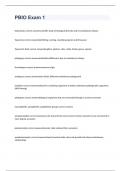
-
PBIO Exam 1 2023 with 100% correct answers
- Exam (elaborations) • 9 pages • 2023
-
Available in package deal
-
- $13.99
- + learn more
Systematics correct answersscientific study of biological diversity and its evolutionary history Taxonomy correct answersidentifying, naming, classifying species (call linnaeus) Taxonomic Rank correct answerskingdom, phylum, class, order, family, genus, species phylogeny correct answerssimilarities/differences due to evolutionary history Homologous correct answerscommon origin analogous correct answerslook similar, different evolutionary background cladistics correct answersmet...
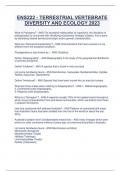
-
ENS222 - TERRESTRIAL VERTEBRATE DIVERSITY AND ECOLOGY 2023
- Exam (elaborations) • 10 pages • 2023
-
- $11.99
- + learn more
ENS222 - TERRESTRIAL VERTEBRATE DIVERSITY AND ECOLOGY 2023 What is Phylogeny? - ANS-The ancestral relationships of organisms. the discipline of phylogenetics is concerned with identifying evolutionary lineages (clades). this is done by identifying shared derived phenotypic and/or genetic characteristics. What are "Derived characteristics"? - ANS-Characteristics that have evolved (i.e are different from the ancestral condition). Phyolgenetics is also known as.. - ANS-Cladistics. Def...
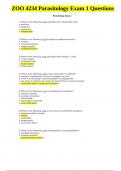
-
ZOO 4234 Parasitology Exam 1 Questions and Answers Latest Updated 2024 (Verified)
- Exam (elaborations) • 8 pages • 2023
-
- $15.49
- + learn more
ZOO 4234 Parasitology Exam 1 Questions and Answers Latest Updated 2024 (Verified). Which of the following is not associated with natural killer cells? a. perforins b. apoptosis c. granzymes d. phagocytosis 2) Which of the following is not an aspect of adaptive immunity? a. memory b. nonself recognition c. antigen-specific d. localized response 3) Which of the following is not associated with cytotoxic T cells? a. T-cell receptor b. kill infected cells c. B-cell receptor d. CD8 rece...

How did he do that? By selling his study resources on Stuvia. Try it yourself! Discover all about earning on Stuvia


